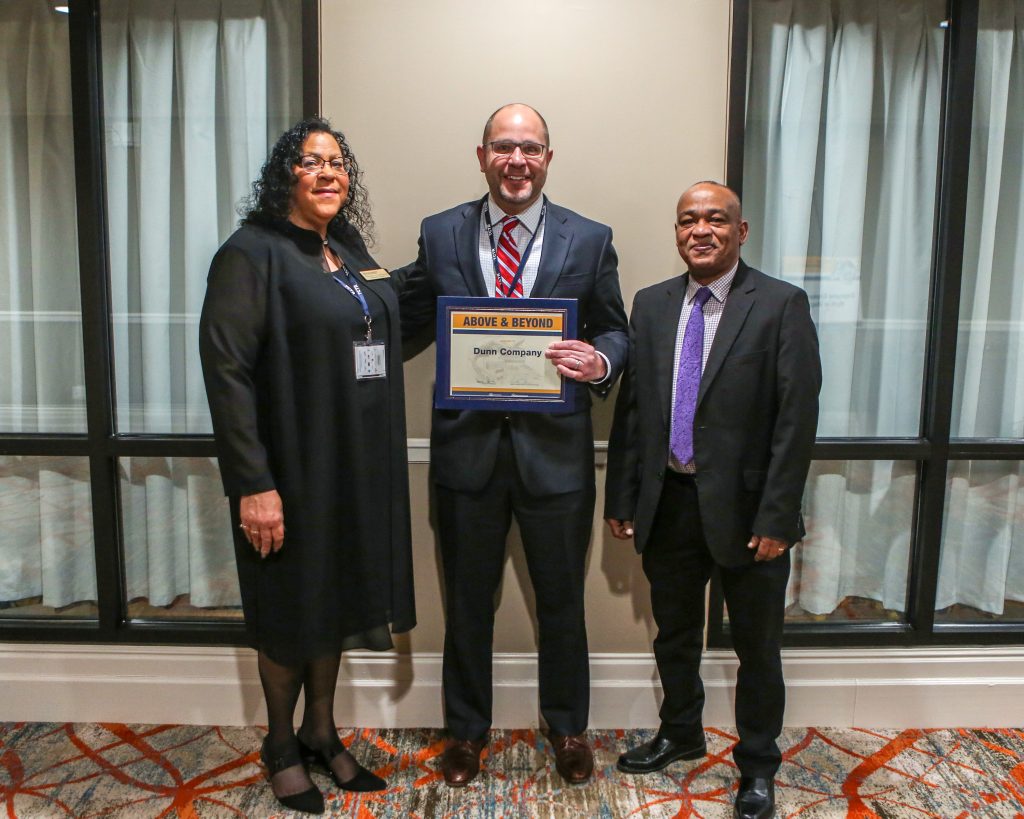Category: News
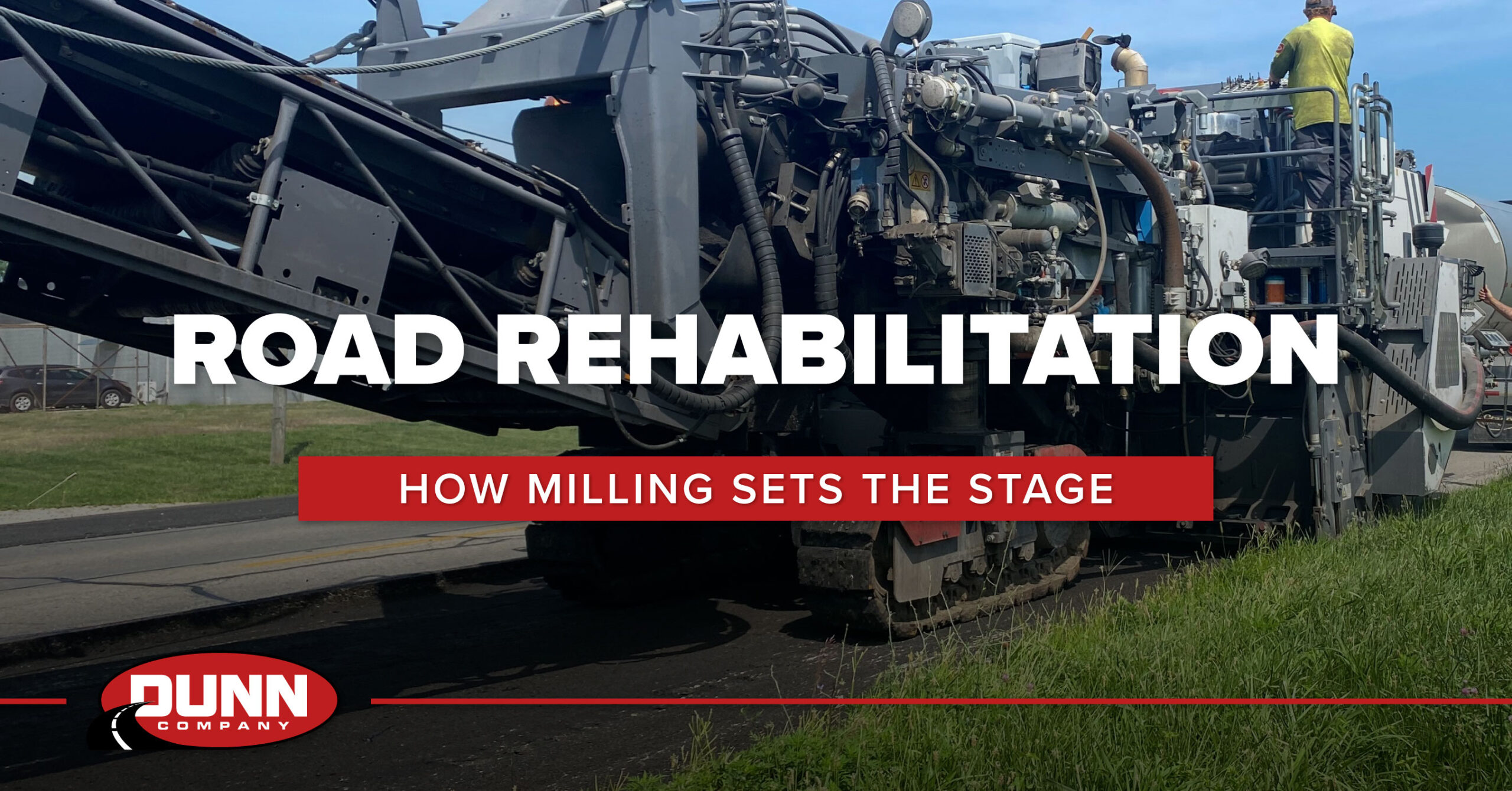
How Milling Sets the Stage for Successful Road Rehabilitation
When it comes to successful road rehabilitation projects, proper preparation is everything and that starts with milling. At Dunn Company, we specialize in precision asphalt milling designed to create the ideal foundation for long-lasting pavement. Whether you’re managing county highways, municipal streets, or other asphalt pathways, milling ensures a smooth, stable, and cost-effective base for new asphalt to be applied.
What Is Milling and Why It Matters
Milling involves removing a controlled layer of existing asphalt to create a smooth and even base for repaving. This process allows engineers and contractors to correct surface irregularities, improve drainage, and prepare the structure for a new layer of pavement. Milling offers several critically key advantages:
- Improved Surface Quality: Ensures the new pavement sits on a uniform foundation.
- Better Durability: Extends the lifespan of the roadway or parking lot by addressing structural issues early.
- Cost Efficiency: Reclaimed material from milling can be recycled and reused, reducing project costs and environmental impact.

Dunn Company’s Expertise in Milling
With decades of experience, Dunn Company delivers state-of-the-art milling services across Illinois and throughout the Midwest. Our team combines advanced equipment, industry knowledge, and innovative technology to deliver consistently accurate and efficient results.
Precision Milling Capabilities
- Variable Widths: We can mill in various widths ranging from 18 inches up to 14 feet, making it possible to handle projects of virtually any scale from small patching jobs to half lane and full roadway reconstruction.
- Micro Milling: Dunn Company is one of the only contractors to provide micro milling at a full 12’6” width. This capability allows us to achieve an exceptionally smooth and consistent surface finish, ideal for specialized applications where precision matters most.
- Sensor-Based Leveling: Our equipment utilizes an advanced sensor-based leveling system to detect and correct surface irregularities in real time. By taking average readings over a wider area, we achieve more accurate milling depths and produce smoother, more uniform surfaces.
Our Milling Process
Regardless of project size or scope, our approach remains the same:
- Assess the existing pavement structure
- Identify elevation and drainage concerns
- Remove the precise amount of material needed for a balanced base
- Prepare the site for a high-quality asphalt overlay
This level of precision ensures that the final pavement delivers maximum performance, longevity, and safety.
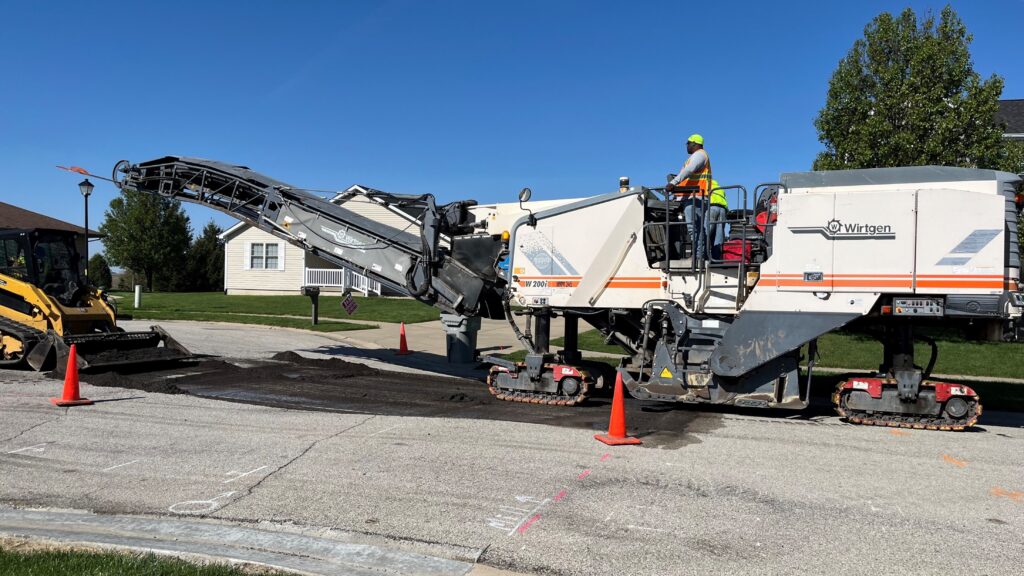
Applications Beyond Roadways
While milling is essential for municipal infrastructure projects, its benefits extend far beyond public roadways. We support a wide range of sectors, including:
- Private Residential Developments: Ensuring smoother, longer-lasting neighborhood streets.
- Corporate and College Campuses: Preparing small and large parking lots and access roads with enhanced surface consistency and safety.
- Industrial Facilities: Supporting heavy-duty surfaces designed to withstand increased traffic and load demands.
By tailoring our approach to the specific needs of each project, Dunn Company delivers milling solutions that ensure every surface, whether public, private, or institutional, performs at its highest potential.
Building Stronger Roads, Together
At Dunn Company, we don’t just focus on asphalt, we focus on impact. From small local streets to major regional infrastructure, our team works closely with civil engineers, planners, and municipalities to deliver solutions that strengthen communities and keep people moving. Through our milling expertise, we help lay the groundwork for safer, longer-lasting, and more cost-effective road systems across the Midwest.
Contact Dunn Company today to learn more about how we can assist with your next project.

Proper Driveway Paving = Smooth Lasting Results
A freshly paved driveway doesn’t just improve your home’s curb appeal, it adds real value, increases functionality, and protects your property for the long haul. But not all driveways are created equal. The difference between a surface that lasts decades and one that crumbles within a few years often comes down to one thing: the process.
When done right, your driveway will stand up to daily use, changing weather, and the test of time. But when corners are cut or key steps are skipped, results such as premature cracking, drainage issues, or even the need for a full replacement could develop within just a few years. Quality paving begins with understanding what lies beneath the surface and ensuring every layer is built to last.
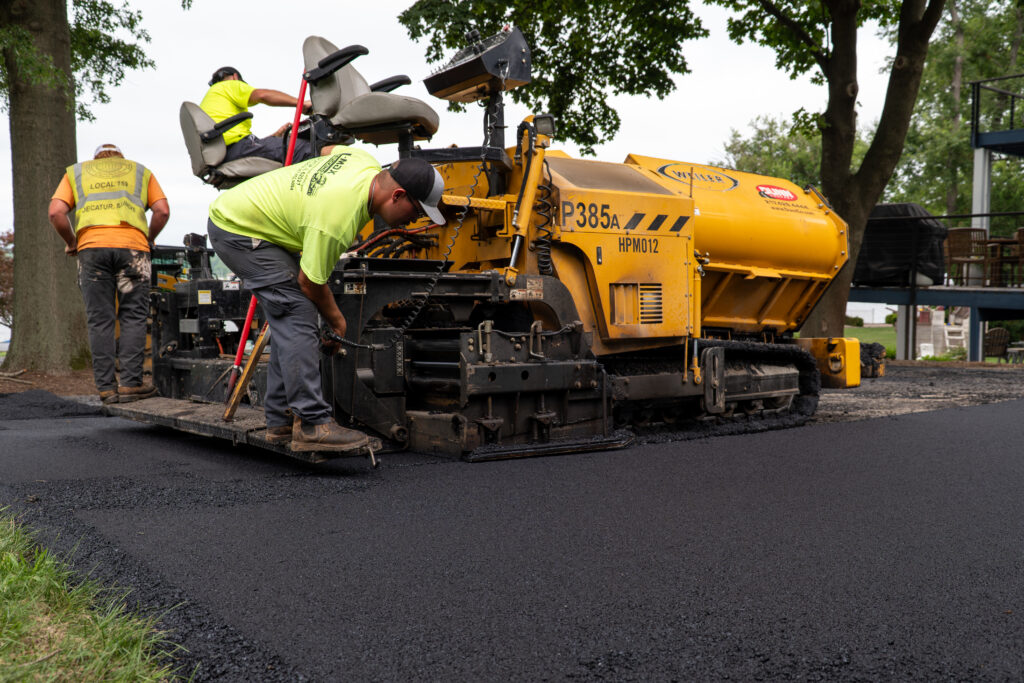
At Dunn Company, we believe in doing it right the first time. Here’s why it matters to you as a homeowner.
1. Thorough Site Inspection
Before a single machine touches your property, our team conducts a comprehensive inspection. We evaluate:
- Existing pavement conditions: Is there surface cracking, rutting, or base failure?
- Subgrade conditions: What type of soil lies beneath your driveway? Clay-heavy soils may require more stabilization.
- Drainage and water flow: Water is the enemy of pavement. We check for slopes, pooling areas, and downspout direction.
- Traffic patterns and loads: Do you park large vehicles or equipment? Will there be frequent deliveries?
This step ensures we don’t just repave, we design your project to meet your property’s specific needs.
2. Base Preparation
The base layer of your driveway is like the foundation of your home, without a solid base, nothing else matters.
What makes a proper base?
- Depth: Most residential driveways require 4 to 8 inches of compacted aggregate base depending on subgrade conditions.
- Material: We use high-quality, graded crushed stone for optimal drainage and compaction.
- Compaction: Proper compaction eliminates air voids and creates a dense, stable platform.
Without a properly compacted and stable foundation, the asphalt above is vulnerable to shifting, settling, and cracking over time. This often leads to visible issues like tire depressions, crumbling edges, and uneven surfaces. If the base isn’t right, the surface won’t hold up, no matter how good the asphalt mix is.
3. Smart Drainage
Water infiltration is one of the main causes of asphalt failure. That’s why we prioritize water drainage design before and during installation.
- Proper slope so water runs away from your home and toward designated runoff points.
- Edge reinforcement to prevent crumbling where water tends to pool.
- Seam sealing to keep moisture out of vulnerable joints and transitions.
Even the best asphalt won’t last if water seeps underneath and weakens the base. This can erode or weaken the base, undermining the entire structure. Over time, trapped moisture may freeze and expand, causing frost heave that pushes the asphalt upward and leads to cracking or uneven spots. Even the highest quality asphalt can fail if it is compromised by poor water management.
4. Asphalt Application
After the base is properly installed and compacted, it’s time to pave. We take care to ensure every layer of your driveway is built to last, starting with quality materials and proper thickness.
Proper Thickness for Performance
We apply asphalt at the correct thickness based on the conditions of your property, the expected load, and industry best practices. Applying asphalt too thin leads to early deterioration, while the correct thickness supports longevity, strength, and value.
- Standard residential driveways typically receive 2 to 3 inches of compacted asphalt.
- Heavier-use areas, like those used for RVs or trailers, may require additional thickness for stability.
Consistent, Controlled Installation
Asphalt is applied while hot and must be spread evenly before it cools. Our team uses properly calibrated equipment and precision techniques to ensure a smooth, uniform surface that looks and performs its best.
- Edges are finished cleanly to prevent cracking and separation.
- We monitor temperature, weather, and compaction rates throughout the job to ensure a high-quality finish.
Final Compaction
Every driveway is compacted with precision rollers to bond the asphalt and eliminate air pockets. Our compaction process ensures the surface is sealed, strong, and able to handle both vehicles and weather over its lifetime.
6. Aftercare & Maintenance Tips
Once your new driveway is installed, proper care helps you get the most out of it:
- Avoid parking on the new surface after installation.
- Sealcoat to protect against UV rays, oxidation, and surface wear.
- Don’t use sharp objects or heavy equipment on the surface to avoid scraping or damaging the surface.
We’ll walk you through best practices so you can preserve your investment for years to come.
Your Local Paving Experts
We’ve been paving roads, driveways, and parking lots for decades. But what sets us apart is our commitment to long-term quality and customer service. We don’t just show up with machines, we show up with a plan, tailored specifically for your property, your needs, and your future.
Ready to Invest in a Better Driveway?
Whether you’re replacing old pavement or starting from scratch, Dunn Company ensures your residential paving project is built on experience, precision, and care, from the ground up.
Contact us today for a free consultation and see how a professionally built driveway can transform your property inside and out.
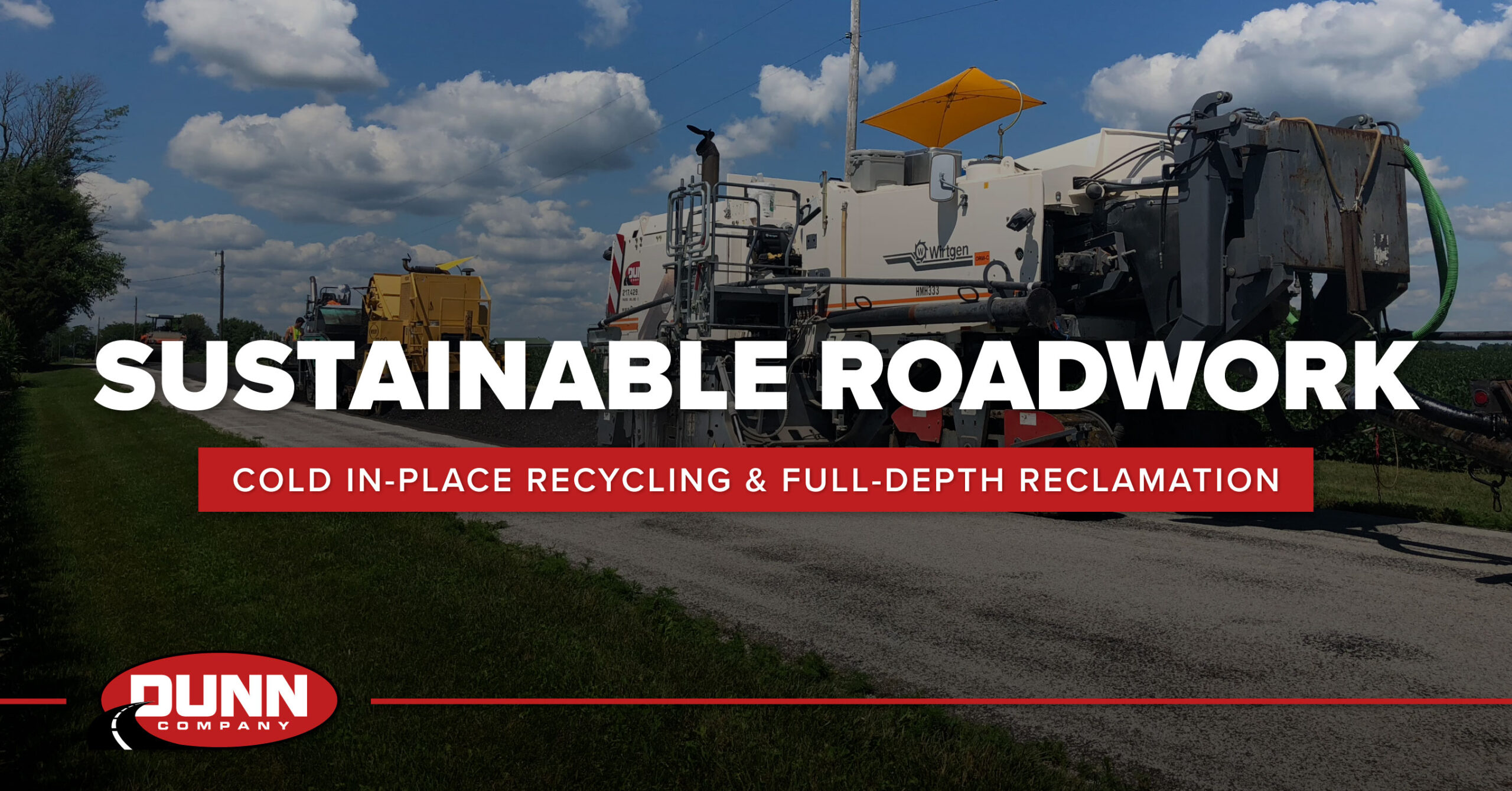
Sustainable Roadwork: Paving a Better Future
Across the country, communities are rethinking how roads are built and rebuilt. With growing attention on environmental impact, long-term performance, and cost-efficiency, sustainable roadwork is more than just a trend. It’s the future. And at the forefront of this evolution are two standout methods: Cold In-Place Recycling (CIR) and Full-Depth Reclamation (FDR).
These advanced processes don’t just fix roads, they redefine how we approach infrastructure by reducing waste, preserving materials, and improving durability.

A New Standard in Road Rehabilitation
Conventional reconstruction methods often require full removal of existing pavement, hauling in new materials, and multiple passes with heavy machinery. CIR and FDR flip that model on its head by working smarter:
- CIR recycles the existing top layers of asphalt right on the roadway, mixes them with stabilizing agents, and repaves all in a single, efficient process.
- FDR takes it even further, reclaiming the full depth of pavement and base, strengthening it with additives like cement or emulsion, and preparing it for a long-lasting new surface.
Both methods eliminate waste, reduce haul distances, and minimize the need for new materials. That’s sustainability in action.
Smarter Roads, Built In-Place
Why tear up and truck out tons of old pavement when the solution is already beneath your feet? CIR and FDR maximize the value of what’s already there. By reusing and improving existing materials, we reduce emissions, fuel use, and landfill burden without compromising quality.
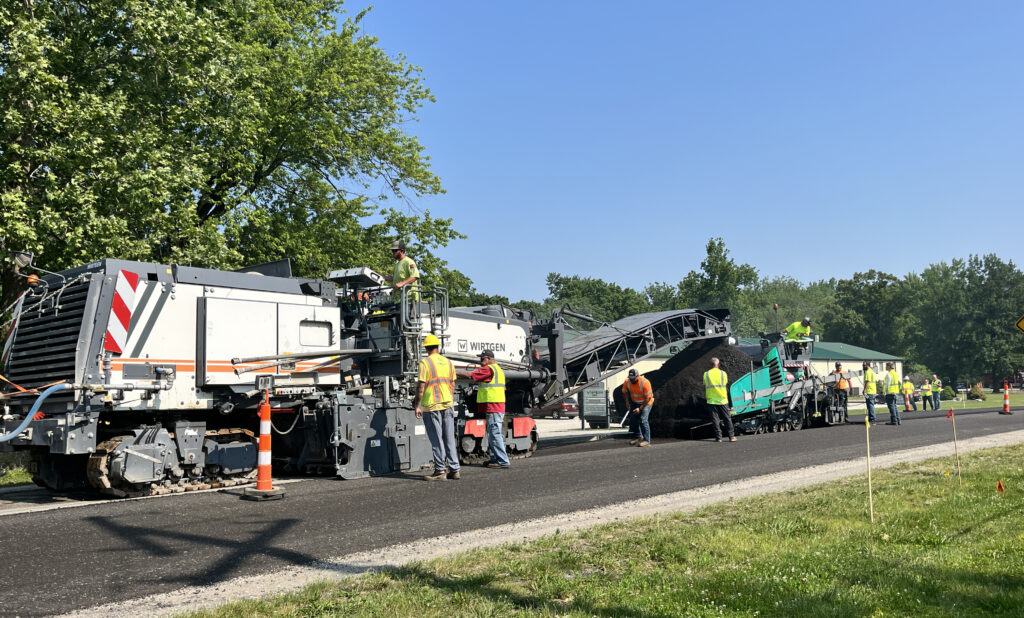
Designed to Last
These methods aren’t just eco-friendly, they’re tough. Roads treated with FDR, for example, often outlast traditional rebuilds thanks to a stabilized base and better resistance to heavy loads. CIR-treated roads maintain smoother surfaces and stronger bonds, helping prevent future damage.
For projects in rural areas or industrial zones, like those supporting renewable energy infrastructure, this added strength is key. These roads need to handle oversized equipment, consistent traffic, and extreme weather. CIR and FDR deliver every time.
The Sustainable Choice for Every Stakeholder
Municipalities benefit from reduced construction timelines and long-term savings. Contractors gain process efficiency and reduced material handling. Residents enjoy quicker turnarounds and safer, smoother streets.
And all of us benefit from lower carbon emissions and smarter use of resources.
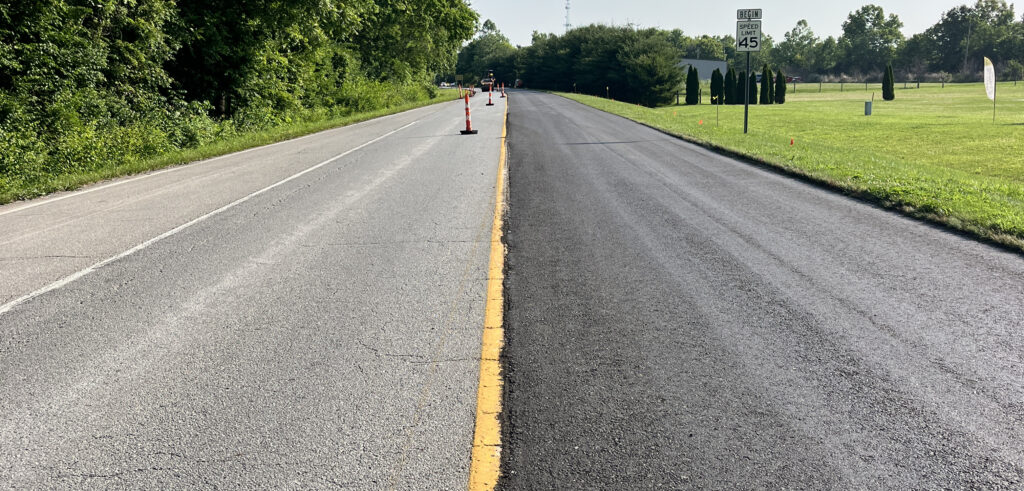
The Road Ahead
Sustainability in roadwork isn’t about sacrificing performance. It’s about elevating it. Through innovative processes like Cold In-Place Recycling and Full-Depth Reclamation, we’re not just patching problems, we’re building roads that are cleaner, stronger, and built to last.
At Dunn Company, we’re proud to lead the charge. Because better roads begin with better methods and a better future starts right beneath our wheels.
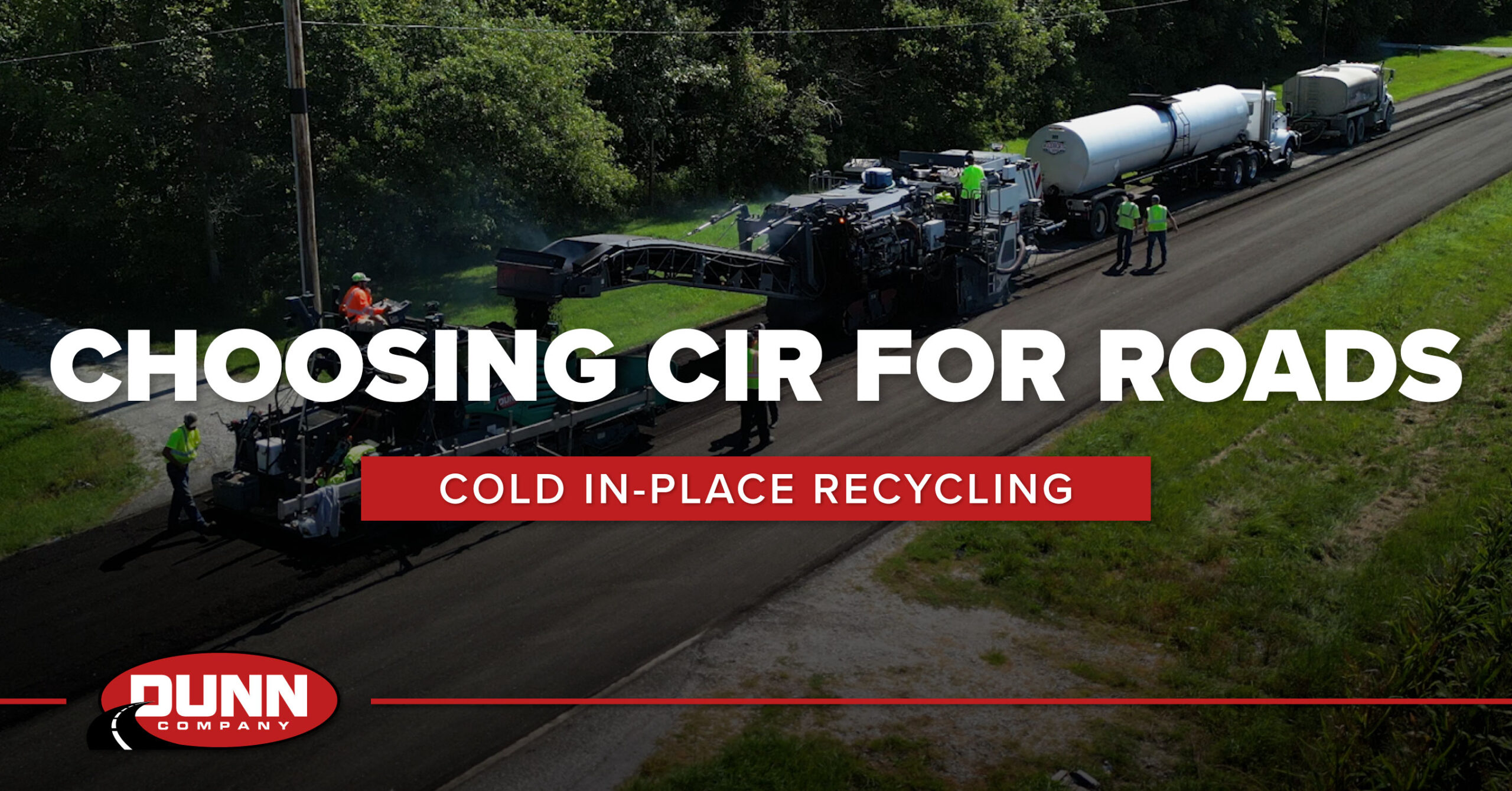
When Is Cold In-Place Recycling the Right Choice for Your Roads
Cold In-Place Recycling (CIR) is gaining traction across the Midwest as more agencies and contractors look for pavement preservation methods that extend road life, reduce costs, and support sustainable infrastructure goals. But while CIR offers several advantages, it isn’t the right solution for every road. We will walk through what CIR is, where it works best, and how to evaluate whether it fits your next project.

Understanding CIR: A Smarter Way to Rebuild Roads
CIR is an in-place pavement rehabilitation technique that recycles and repurposes the existing asphalt surface. Rather than hauling away old pavement and bringing in new materials, CIR uses a train of equipment to mill the surface, typically 2 to 5 inches, blend it with a stabilizing agent, and is recompacted on-site to form a new, stabilized base layer.
The result? A strong, uniform layer that’s ready for a new surface treatment. Whether that’s hot-mix asphalt, chip seal, or another wearing course. CIR can extend the life of a road by 10 to 20 years, all while using fewer resources and creating less disruption to traffic.

Why Agencies Are Turning to Cold In-Place Recycling
Cold In-Place Recycling offers a mix of economic, environmental, and operational benefits that make it especially attractive to public agencies and engineers:
- Cost Efficiency: CIR can save up to 50% compared to traditional mill-and-overlay or full-depth reconstruction. Fewer materials, fewer haul trucks, and shorter project timelines all contribute to savings.
- Sustainability: CIR reuses up to 100% of the existing asphalt material. That reduces the need for new aggregate and asphalt binder, lowers emissions, and minimizes material waste.
- Quicker Turnaround: Roads can often remain open to local traffic during construction, and final surfacing can follow in just a few days after curing, reducing delays for residents and businesses in the area.
- Improved Performance: CIR creates a stable, consistent base, eliminating deep cracks, ruts, and fatigue issues while also reducing reflective cracking through the new surface layer.
Where CIR Fits Best
While CIR is versatile, it’s not a one-size-fits-all solution. It’s most effective on low- to medium-volume roads with surface-level distress and a structurally sound base. In these cases, CIR can correct damages such as:
- Alligator cracking
- Rutting or shoving
- Moisture infiltration
- Raveling or surface oxidation
It’s also a great solution for roads serving renewable energy sites, residential developments, and rural access routes where maintaining pavement condition with minimal disruption is key.
How to know if CIR is Right for Your Project
- What’s the Condition of the Existing Pavement?
CIR works best when the damage is confined to the surface layer and the base remains intact. If there are major structural failures or deep subgrade issues, a full-depth reclamation (FDR) or reconstruction may be more appropriate. - Can the Existing Materials Be Recycled?
A mix design and lab testing are essential. Asphalt content, gradation, and binder performance must be evaluated to ensure the materials will produce a consistent and durable CIR layer. - Is the Climate Favorable?
CIR requires warm, dry conditions to allow the stabilized layer to cure properly before the final surface is placed. The construction window may be shorter in cooler, wetter regions. - What Is the Budget and Timeline?
If cost and schedule are priorities, CIR’s streamlined construction process and lower material demands can deliver significant savings in both areas. - Is the Right Team and Equipment Available?
CIR requires specialized equipment and experienced crews. Working with a contractor like Dunn Company who understands and specializes in the process and coordinates with project engineers and stakeholders is critical to success.
A Collaborative Approach
CIR isn’t a replacement for surface treatments or hot mix paving. It’s a tool and one that works best when integrated into a broader pavement management program. At Dunn Company, we regularly partner with agencies, engineers, and general contractors to deliver CIR as part of a multi-phase solution. Whether that means CIR followed by a chip seal, a thin lift of hot mix, or additional stabilization, we ensure the process fits the needs of the road and the goals of the owner.

Plan Early, Deliver Better Roads
Cold In-Place Recycling isn’t just about saving money, it’s about doing more with less, building longer-lasting roads, and using our resources responsibly. If you’re an engineer, consultant, or contractor involved in road rehabilitation planning, consider CIR early in your design process. With proper planning, CIR can help you stretch your budget, reduce environmental impact, and deliver safer, more reliable infrastructure for the communities you serve.
Ready to Explore Cold In-Place Recycling?
If you’re considering CIR for your next project or want to learn more about how it can support your pavement preservation goals, the team at Dunn Company is ready to help. With decades of experience, specialized equipment, and a proven track record across the Midwest, we’re the trusted partner for reliable, efficient road rehabilitation. Contact us today to see how Cold In-Place Recycling can work for your roads.
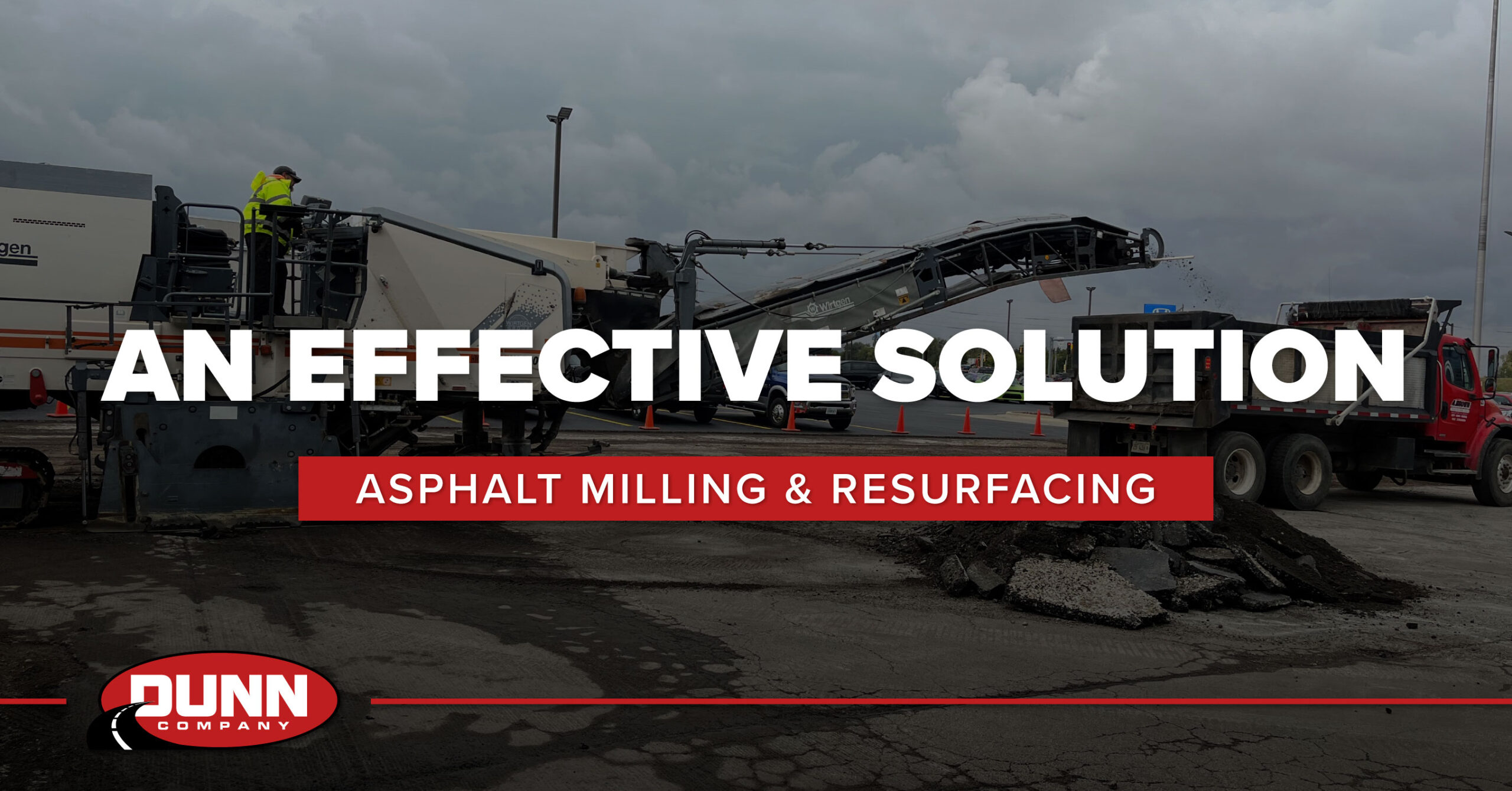
Asphalt Milling and Resurfacing, An Efficient Solution
Asphalt milling and resurfacing are two of the most efficient and cost-effective solutions for maintaining and restoring aging or damaged roadways. These methods provide municipalities, contractors, and counties with the means to extend the life of roads, improve ride quality, and reduce long-term maintenance costs. We will cover the basics of asphalt milling, resurfacing, and the role they play in the rehabilitation of roadways.
What is Asphalt Milling?
Asphalt milling is a process used to remove a layer of deteriorating asphalt from the surface of a road. This technique involves using a milling machine to grind the asphalt surface into small particles, which are then collected and recycled. Asphalt milling is often used to address surface-level issues such as cracks, potholes, and ruts, allowing for a more efficient and cost-effective repair than full removal and replacement.

The primary benefits of asphalt milling include:
- Sustainability: Since the milled asphalt can be recycled and reused, the process minimizes waste and reduces the need for new materials.
- Cost-Effective: Milling is less expensive than complete pavement replacement and can be completed in less time.
- Reduced Traffic Disruption: Asphalt milling allows for localized repairs, meaning less disruption to traffic flow and fewer road closures.
How Does Resurfacing Follow Milling?
Once the asphalt has been milled, resurfacing is often the next step in the road rehabilitation process. Resurfacing involves applying a new layer of fresh asphalt over the milled surface, restoring the smoothness and integrity of the road. This process addresses issues such as cracks, ruts, and surface imperfections, improving both the ride quality and the safety of the road.
The benefits of resurfacing include:
- Enhanced Durability: The new layer of asphalt adds strength and longevity to the pavement, extending the life of the road.
- Improved Ride Quality: Resurfacing smooths out the surface, providing a more comfortable and safer driving experience.
- Cost Savings: Rather than tearing up the entire pavement, resurfacing offers a more affordable way to restore roads that are still structurally sound.
When to Use Asphalt Milling and Resurfacing
The decision to use milling and resurfacing depends on the condition of the existing pavement. Milling is typically used for roads with surface-level damage, while resurfacing is an effective solution for roads with worn or cracked surfaces but still in good structural condition. Here are some factors to consider when deciding whether to use milling and resurfacing:
- Surface Damage: Milling is ideal for addressing cracks, potholes, and other surface-level issues.
- Structural Integrity: If the base of the road is still strong, resurfacing can restore the road without needing full reconstruction.
- Cost-Effectiveness: Milling and resurfacing are more affordable than complete road replacement, making them a great option for extending the life of existing infrastructure.
Cold In-Place Recycling (CIR) – A Complementary Solution
While asphalt milling and resurfacing are effective methods for maintaining roads, there are times when a more comprehensive solution is needed. Cold In-Place Recycling (CIR) is one such solution. CIR is a process in which the existing asphalt surface is milled, mixed with a stabilizing agent, and re-compacted to create a new, durable road base.
The benefits of CIR include:
- Stronger Road Base: CIR strengthens the road’s foundation, providing greater durability and load-bearing capacity.
- Sustainability: Like milling, CIR recycles existing materials, reducing the need for new asphalt and aggregates.
- Cost Savings: CIR is often more affordable than full road reconstruction, offering a more economical option for rehabilitating severely damaged roads.
While CIR is not always applicable for every project, it can be a great option when a project qualifies for it.
Asphalt Milling and Resurfacing for Efficient Road Repairs
Asphalt milling and resurfacing offer municipalities, engineers, and contractors an efficient, cost-effective way to repair and restore roadways. These methods provide a sustainable solution that minimizes waste, reduces costs, and extends the lifespan of roads. Whether you are addressing minor surface damage or need to restore an aging road, milling and resurfacing are reliable options for maintaining infrastructure.
At Dunn Company, we specialize in asphalt milling, resurfacing, and CIR. Our team has the experience, equipment, and expertise to handle any project, large or small. Whether you’re looking to address surface-level damage or need a more comprehensive solution, Dunn Company has the tools to help keep your roads in top condition.
Contact us today to learn more about how we can help with your road rehabilitation needs.
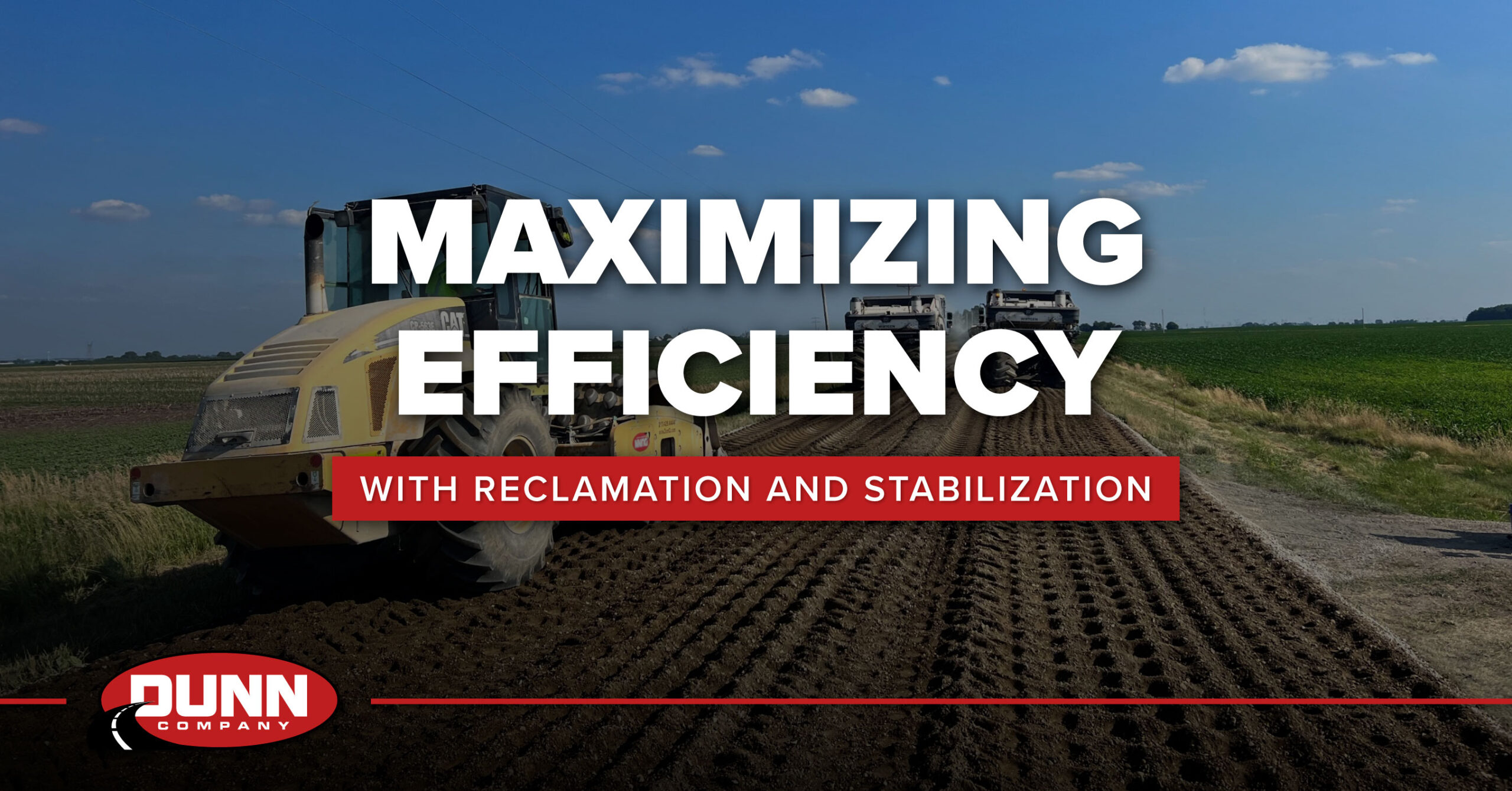
Maximizing Efficiency with Reclamation and Stabilization
When it comes to road construction, efficiency, cost-effectiveness, and sustainability are key. Whether you’re working on highways, local roads, or parking lots, Full Depth Reclamation (FDR) and Soil Stabilization are two innovative techniques that can help you achieve lasting results while saving time, money, and resources. In this article, we’ll explore both methods and highlight their advantages for road reconstruction projects.
What is Full Depth Reclamation (FDR)?
Full Depth Reclamation (FDR) is an advanced road construction technique that involves recycling the existing asphalt and base materials on-site to create a new, stable road base. The process eliminates the need to transport old materials off site, reducing transportation costs, material waste, and environmental impact.
The FDR Process:
- Pulverization: The first step in FDR involves pulverizing the existing asphalt and underlying base materials using specialized machinery. This step creates a consistent, uniform material that can be further processed.
- Mixing and Stabilization: After pulverization, the recycled material is mixed with stabilizing agents such as cement, lime, or emulsion. This mixture helps strengthen the base layer, making it more durable and resistant to environmental stressors.
- Compaction: The stabilized material is then compacted to create a strong, stable foundation that is ready for a new surface layer.
- Paving and Finishing: Once the base has been properly compacted, a new layer of asphalt is applied to complete the project, providing a smooth, durable surface for traffic.
Key Benefits of Full Depth Reclamation (FDR)
- Cost Savings: By reusing existing materials, FDR eliminates the need for new materials and transportation, significantly reducing project costs. This method can save 40% to 80% compared to traditional road reconstruction.
- Time Efficiency: FDR typically requires less time to complete than traditional reconstruction methods. Since the materials are recycled on-site, the construction process is faster, reducing disruptions and allowing roads to be reopened sooner.
- Environmental Benefits: FDR promotes sustainability by recycling materials that would otherwise be taken off site. It reduces the carbon footprint associated with the extraction, transportation, and disposal of raw materials.
- Improved Road Performance: FDR strengthens the base layer, improves the structural coefficiency, integrity and lifespan of the road efficiently. It also reduces issues such as cracking, ruts, and surface distress, resulting in a smoother, more durable surface for years to come.
Understanding Soil Stabilization
Soil stabilization is the process of improving the strength and durability of soil to create a more solid foundation for road construction. By stabilizing the soil, construction teams can ensure that the road base remains strong, even under heavy loads and varying weather conditions.
Methods of Soil Stabilization:
- Mechanical Stabilization: This method involves physical processes such as compaction. Mechanical stabilization is ideal for improving soil strength and density quickly and efficiently.
- Chemical Stabilization: In this process, stabilizing agents like cement, lime, or fly ash are mixed with the soil to alter its chemical properties. This improves the soil’s load-bearing capacity and resistance to moisture and erosion.
Benefits of Soil Stabilization
- Improved Load-Bearing Capacity: Stabilized soil can support heavier loads, reducing the risk of settlement or road failure, especially in areas with soft or unstable soil.
- Enhanced Durability: Stabilized soil is more resistant to erosion, moisture infiltration, and weathering, which improves the overall durability of the road or structure built on top of it.
- Cost Savings: By stabilizing the soil in place, you reduce the need for extensive excavation or replacement, saving both time and money.
- Environmental Sustainability: Soil stabilization reduces the need for new materials, lowering the environmental impact and preserving natural resources. It also minimizes waste by reusing existing soil.
Your Trusted Partner in FDR & Stabilization
At Dunn Company, we specialize in Full Depth Reclamation and Soil Stabilization, offering these services to municipalities, contractors, and construction teams across Illinois and the Midwest. With years of experience and the latest technology, we provide high-quality, cost-effective solutions that ensure your road construction projects are completed on time, within budget, and with lasting results.
Whether you’re looking to rehabilitate an old road or create a stable foundation for new construction, Dunn Company is here to help. Contact us today to learn more about how FDR and soil stabilization can benefit your next project.

Renewing Foundations for Renewable Energy
As the push for renewable energy continues to grow, wind and solar farm projects face a unique set of challenges. These large-scale infrastructure projects require careful planning and execution to ensure they are built on solid, sustainable foundations that can withstand the heavy equipment involved, environmental factors, and the demands of the energy sector.
One of the key elements in the successful construction of renewable energy projects is ensuring the proper stabilization of soils, building robust access roads, and improving local infrastructure to handle the weight and movement of heavy machinery. For engineers and construction professionals, making the right choices early on can ensure efficiency, cost-effectiveness, and longevity, ultimately reducing the project’s carbon footprint.
Soil Stabilization for Renewable Energy Projects
The first critical step in preparing for any renewable energy project is soil stabilization. Without a solid base, any road infrastructure will quickly degrade, especially under the weight of the heavy cranes, turbine components, and other equipment that must be transported on-site. Soil stabilization serves as the foundation for a durable and long-lasting road system.
Stabilizing the soil to withstand the harsh conditions of these projects often involves soil-cement stabilization, which is an environmentally friendly and cost-effective solution. Cement stabilization is particularly beneficial for roads that will be exposed to dynamic loads and frequent heavy equipment transport, such as those in wind and solar farm construction.
For engineers, it is essential to conduct geotechnical studies to assess the soil type and determine the most effective cement ratio for stabilization. This ensures the mixture is tailored to the varying terrain conditions, maximizing the strength and durability of the soil. The design process should also take into account drainage, as water retention can weaken stabilized layers and lead to costly repairs down the line. By incorporating additives like fly ash or lime, roads can gain enhanced resistance to moisture-related damage, providing long-term durability.
Once the soil is stabilized, field testing is often performed to validate the strength of the stabilized road base. Common tests, such as California Bearing Ratio (CBR) and Unconfined Compressive Strength (UCS), help to determine whether the stabilized soil will meet the performance standards required for the project.
Building Access Roads for Heavy Equipment
In addition to the soil stabilization, creating access roads for large machinery is another crucial step in the construction process. These roads are necessary for the transportation of turbine components, cranes, and solar panels, all of which are too heavy and large to be transported on standard roads. Access roads must be designed to handle these heavy loads without deteriorating under the stress.
The road construction process involves more than just pouring asphalt, it requires proper thickness and reinforcement to ensure that these access roads can handle the load-bearing requirements. Engineers need to consider structural design that takes into account the specific needs of transporting large equipment and providing access to remote areas.
In addition, the use of cement stabilization for these access roads ensures that they remain strong and durable, even in harsh weather conditions. This approach prevents common issues such as erosion, cracks, and ruts, which can significantly increase maintenance costs and disrupt operations.
Improving Infrastructure for Long-Term Sustainability
When working on renewable energy projects, there is often a need to improve existing local infrastructure. Public roads and local access roads must be reinforced to allow for the movement of heavy equipment while also supporting long-term use and maintenance. Roadways must be designed with proper drainage systems to prevent water buildup, which could weaken the integrity of the roadbed. The goal is to ensure that these roads can withstand the harsh environmental conditions while providing reliable access to the project site.
Improving these roads, especially in rural areas where many renewable energy projects are located, helps local municipalities maintain infrastructure that benefits not only the energy project but also the surrounding community. Dunn Company works closely with local authorities and engineers to ensure that the necessary road improvements are made in accordance with project timelines while adhering to all safety and environmental regulations.
Reducing Environmental Impact with Full Depth Reclamation and Cold In-Place Recycling
Sustainability is at the heart of renewable energy projects, and this goal should extend to the construction process as well. One effective way to reduce the environmental impact is by incorporating techniques like Full Depth Reclamation (FDR) and Cold In-Place Recycling (CIR). These methods minimize the use of new materials by reusing existing asphalt and base materials, reducing both the cost and the carbon footprint of the project.
Integrated Carbon Emissions from Asphalt Pavement Regeneration (www.mdpi.com)
FDR is particularly useful for projects that require extensive road rehabilitation, as it pulverizes the existing pavement and mixes it with stabilizing agents to create a new, stronger road base. CIR similarly helps by milling existing asphalt and reusing it, reducing the need for new aggregates and reducing the carbon footprint associated with material transportation.
Both of these techniques contribute to lowering transportation costs and reducing construction waste, aligning perfectly with the sustainability goals of renewable energy projects. By using these innovative methods, renewable energy projects can significantly reduce their environmental impact while still meeting the durability and performance needs of the project.
A Comprehensive Approach for Renewable Energy Projects
Renewable energy projects require a comprehensive and cohesive approach to site preparation, from soil stabilization to access roads and local infrastructure improvements. By addressing the unique challenges of heavy equipment transport, road durability, and environmental concerns, engineers and contractors can help ensure the long-term success of the project.
Working with Dunn Company provides an opportunity to utilize industry-leading techniques and innovative approaches to reduce costs, minimize environmental impact, and ensure that the necessary infrastructure is in place for long-term sustainability.
Our expertise in soil stabilization, access road creation, and full-service infrastructure improvements makes us a trusted partner for your renewable energy projects. With the right planning and execution, your renewable energy projects can achieve their full potential, benefiting the environment, your business, and the communities they serve.
Contact a Dunn Company representative today to learn more about how we can help with your next project.

Why Choose Asphalt for Your Home’s Driveway
When it comes to your driveway, choosing the right pavement type can make a significant difference in both the aesthetic and functional aspects of your property. While there are several options available, asphalt pavement stands out as one of the best choices for many homeowners. Here’s why asphalt pavement should be at the top of your list when considering a driveway for your home.
Durability You Can Count On
Asphalt driveways are known for their durability and longevity. Properly designed and constructed, an asphalt pavement will withstand harsh weather conditions, heavy traffic, and the wear and tear of everyday life. Whether you’re dealing with freezing winters or hot summers, asphalt pavement maintains its structural integrity.
Cost-Effective Solution
Asphalt pavement is frequently more economical to install compared to alternatives, making it an affordable option for homeowners. Additionally, asphalt driveways are also more economical to maintain. With proper maintenance, sealing, crack-filling, and other minor repairs, an asphalt driveway can provide greater value without the hefty upfront costs.
Quick Installation
If you’re looking to get your driveway paved quickly, asphalt is the way to go. The installation process for asphalt pavement is typically faster compared to other materials. Most residential asphalt driveways can be installed within a few days, and you’ll have full use of the driveway in a short amount of time. This makes asphalt a convenient option if you want to avoid long construction times and the disruption that comes with it.
Low Maintenance
Asphalt driveways are known for their low maintenance requirements. Routine maintenance, such as resealing and filling in cracks, is all that’s needed to keep your driveway in great shape. The durability of asphalt pavement and ease of care, save you time and money.
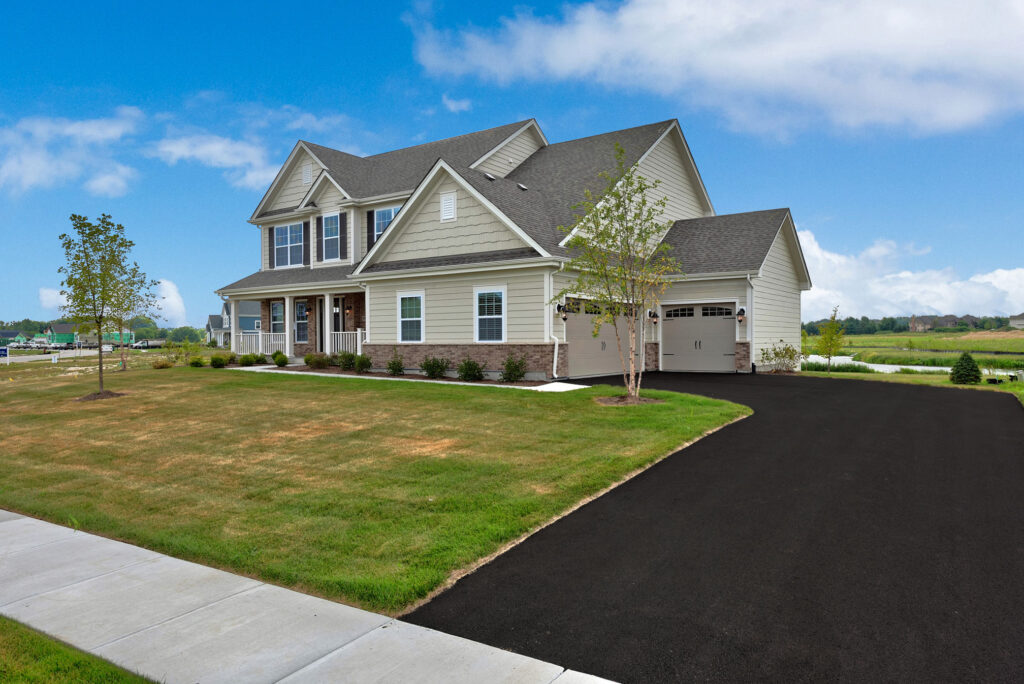
Aesthetic Appeal
An asphalt driveway offers a sleek, smooth, and uniform look, which adds curb appeal to any home. It’s easy to customize the finish of an asphalt driveway to complement the overall look of your home. Asphalt pavement provides a rich, black color that enhances the appearance of your property. You can easily refresh this look by having sealer applied when needed. The asphalt’s smooth surface and dark color also make removing snow and ice more efficient.
Environmentally Friendly
The Environmental Protection Agency (EPA) recognizes asphalt pavement as one of the most-recycled materials in the United States. In addition, far less energy is required to produce asphalt than alternative pavement materials. These factors make asphalt a sustainable choice for new construction, renovations, and repairs. By choosing asphalt, you’re supporting a product that not only delivers durability and performance but also minimizes its environmental impact over its lifecycle.
Why Asphalt Makes Sense for Your Home
When it comes to choosing a driveway material for your home, asphalt pavement offers a range of benefits. It’s durable, cost-effective, and requires minimal maintenance, making it a practical solution for homeowners looking for a long-lasting, low-maintenance option. Additionally, asphalt’s quick installation and aesthetic appeal make it an ideal choice for those who want a quality driveway that enhances the value of their property.
If you’re looking to pave your driveway, don’t hesitate to consider asphalt as your top choice. Contact us today for an evaluation. Our time-tested process allows us to understand your needs in order to design and build you the best, most cost-effective solution. At Dunn Company, we specialize in residential driveway paving, offering high-quality materials and expert installation to ensure your driveway stands the test of time. That’s the Dunn Advantage, guaranteed.

DUNN COMPANY ACQUIRES ASSETS OF MORSE DRIVEWAYS, REINFORCING LOCAL ASPHALT SERVICES AND STRENGTHENING COMMITMENT TO COMMUNITY

DUNN COMPANY ACQUIRES ASSETS OF MORSE DRIVEWAYS, REINFORCING LOCAL ASPHALT SERVICES AND STRENGTHENING COMMITMENT TO COMMUNITY
Decatur, IL – April 2, 2025 – Dunn Company, a leading regional asphalt paving, milling, stabilization, and recycling contractor, is proud to announce the asset acquisition of Morse Driveways, a local asphalt contractor here in Macon County. This acquisition reinforces Dunn Company’s commitment to serving its local community, focusing on commercial and residential projects throughout the area.
Reinforcing Commitment to Local Service –
“We’re excited to welcome Morse Driveways’ customers into the Dunn Company family,” said David Tyrolt, President of Dunn Company. “We look forward to caring for their driveways and parking lots with the expertise and resources of Dunn Company. We commit to providing our neighbors the high-quality service Dunn Company is known for, and we are honored to be active members of the community. .”
A Stronger, Local Partner– This acquisition demonstrates Dunn Company’s focus on providing asphalt pavement construction and maintenance for driveways and parking lots.
Robby Morse, former owner of Morse Driveways, says, “I am confident that the team at Dunn Company will continue to provide the same level of dependable, high-quality service our customers have come to expect, with the added benefit of their resources and expanded capabilities. I trust that our customers will be in great hands and look forward to the continued success of this transition.”
Continuing Commitment
Dunn Company is dedicated to continuing its legacy of excellence and looks forward to serving both new and existing customers. Our aim is to ensure that every project, large or small, is completed with the same level of reliability and precision that Dunn Company is known for. We remain steadfast in our commitment to building stronger pavements, bases, and communities across Macon County and the Midwest.
About Dunn Company
Founded in 1939, Dunn Company has grown to become one of the leading pavement and base contractors in the region. Specializing in asphalt paving, milling, soil stabilization, full-depth reclamation, cold in-place recycling, and other critical infrastructure services, Dunn Company prides itself on providing dependable, quality service to its clients across the Midwest and right here at home. With a commitment to safety, sustainability, and excellence, Dunn Company has earned a reputation as a leader in the construction industry.
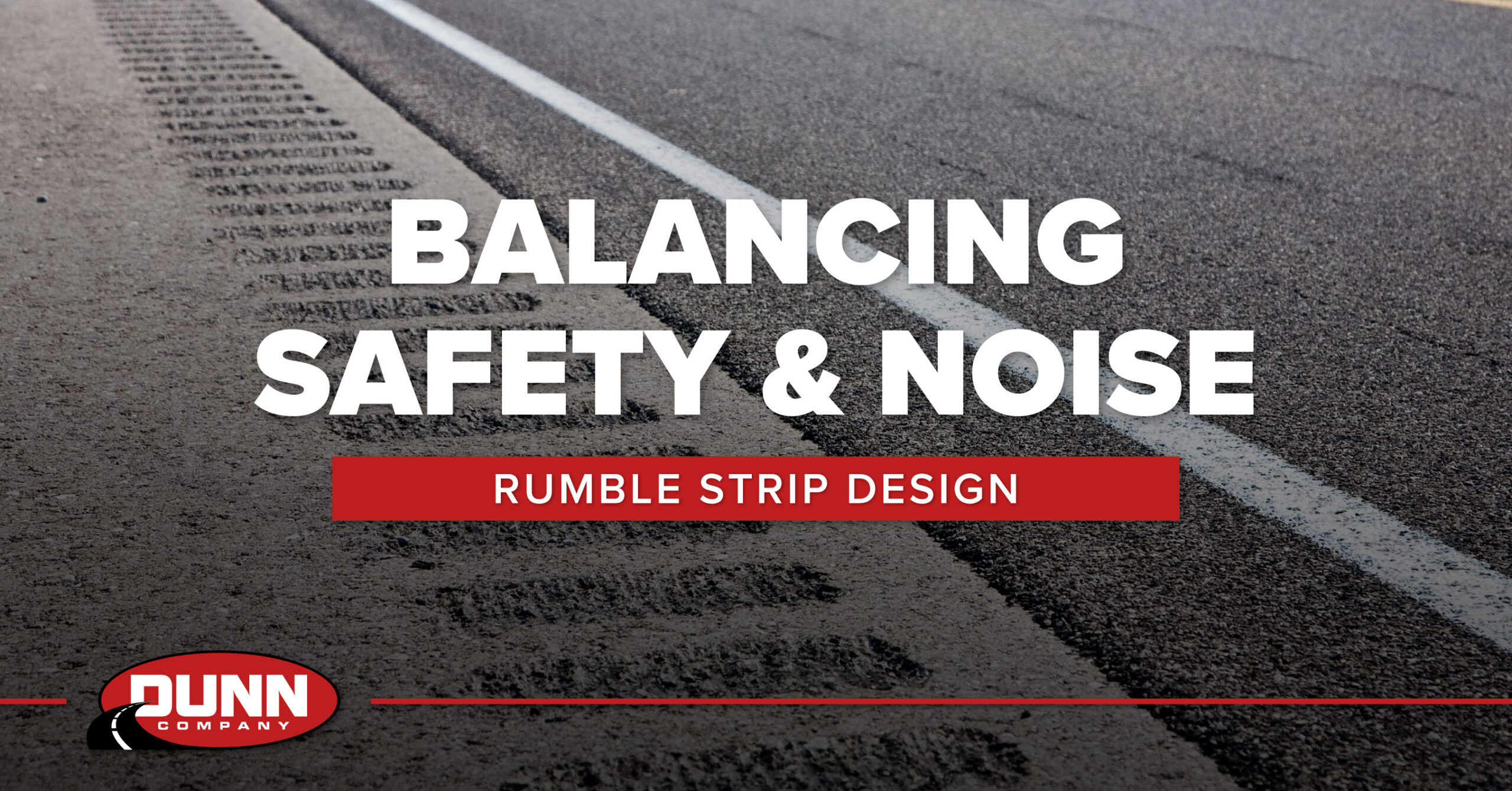
Rumble Strip Design: Balancing Safety and Noise
Rumble strips are a proven and cost-effective safety measure, widely recognized for their ability to prevent roadway departure crashes, including both run-off-road and opposing-direction incidents. These devices provide audible and tactile feedback, alerting drivers when they are unintentionally drifting from their lane or leaving the roadway. However, while rumble strips have long been an essential countermeasure to improve road safety, the external noise they generate has become a significant concern, especially for nearby residents.
With the growing use of rumble strips, transportation agencies have increasingly sought ways to balance their safety benefits with the desire to mitigate noise disruption. In response to this, new designs and research initiatives have emerged that aim to reduce the external noise levels associated with rumble strips while preserving their crash-reduction effectiveness. This article delves into the latest research from the University of Illinois and the Federal Highway Administration (FHWA), along with best practices for implementing rumble strips in a way that minimizes noise while maximizing safety.
Proven Effectiveness for Roadway Safety
The primary function of rumble strips is to alert drivers to unsafe driving behaviors by creating both audible and physical feedback. There are two main types of rumble strips commonly used in roadway safety:
- Centerline rumble strips: Positioned along the centerline of the road, these rumble strips are designed to prevent head-on collisions and opposite-direction sideswipes. They are typically installed on two-lane rural roads, although they can be effective on multilane undivided highways as well. The FHWA reports that centerline rumble strips have reduced head-on and opposite-direction crashes by as much as 45% on rural roads.
- Edge line rumble strips: These are installed along the edge of the roadway to prevent run-off-road crashes, which occur when drivers unintentionally drift off the shoulder. Edge line rumble strips are particularly beneficial for highways and two-lane roads, helping reduce single-vehicle, run-off-road fatalities by 36%.
While these strips effectively reduce crashes, their external noise has raised concerns among residents near high-traffic areas. The challenge, therefore, is to find a balance—ensuring that rumble strips remain effective while minimizing the disruptive external noise that can impact surrounding communities.
Noise Concerns and Research Insights
Noise is a natural byproduct of rumble strips, particularly when vehicles pass over them. The intensity of this noise is a combination of several factors, including the depth of the rumble strip, the frequency of the noise produced, and the proximity of the rumble strip to noise-sensitive areas.
As part of ongoing research, the University of Illinois conducted a comprehensive study on the external noise generated by rumble strips and found significant variations based on design modifications. The study revealed that while traditional rumble strips effectively alert drivers, the external noise they produce can significantly exceed acceptable levels, especially when the rumble strip depth is increased.
In addition to this, the FHWA has long recognized the noise concerns associated with rumble strips, and their “Rumble Strip Implementation Guide” emphasizes the importance of balancing safety with community impact. The guide details several approaches to addressing noise issues, including:
- Placement Considerations: Placing rumble strips further from residential areas or using modifications in design to minimize the frequency of tire contact with the rumble strips.
- Design Adjustments: The FHWA recommends experimentation with varying rumble strip depths and designs to reduce the noise without compromising the safety effectiveness of the strips. These considerations are particularly important for areas where the environmental impact of noise is significant.
Addressing Noise Without Sacrificing Safety
Recent advancements in rumble strip technology are focused on reducing the external noise levels while maintaining or even enhancing the safety benefits of these vital safety features. Several innovative designs are showing promise:
Sinusoidal Rumble Strips
The sinusoidal design, which features a wave-like pattern, has been found to significantly reduce the external noise produced by traditional rectangular rumble strips. According to a study conducted by the California Department of Transportation (Caltrans), external noise from sinusoidal rumble strips is 3 to 7 decibels quieter compared to conventional designs. This quieter design provides a viable solution for reducing noise while still maintaining sufficient in-vehicle noise to alert drivers effectively.
Shallower Depths and Wider Spacing
Other modifications to rumble strip design focus on altering the depth of the cuts and the spacing between the strips. Shallower rumble strips, which are typically in the range of 0.25 to 0.5 inches, have been shown to generate less noise. Additionally, increasing the spacing between each rumble strip can reduce the frequency of noise occurrence without significantly diminishing the safety function of the strips.
Strategic Placement of Rumble Strips
Placement of rumble strips remains a critical factor in addressing noise concerns. Agencies have begun evaluating the placement of rumble strips based on local conditions, including the proximity to residential areas. For example, some agencies are now omitting rumble strips in areas with high resident densities or near sensitive areas, such as schools and hospitals. Other strategies include placing rumble strips further away from the road’s edge to reduce tire contact and minimize noise.
Balancing Noise and Safety
At Dunn Company, we are committed to implementing the most effective and environmentally considerate rumble strip designs available. As experts in roadway construction and safety, we stay at the forefront of rumble strip technology, using the latest research to inform our practices.
We work closely with engineers, public works departments, and safety professionals to design and install rumble strips that maximize safety benefits while minimizing external noise. Whether you’re looking to implement centerline or edge line rumble strips, our team has the experience and knowledge to recommend the best solution for your project.
As rumble strip designs continue to evolve, it’s clear that innovative approaches, such as sinusoidal rumble strips and optimized placement techniques, will help us achieve the delicate balance between safety and noise reduction.
For more information on how Dunn Company can assist with your rumble strip projects, or if you’d like to discuss the latest research and design trends, don’t hesitate to contact our team. We are here to help ensure that your roadway safety measures are as effective and considerate as possible.

